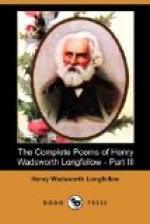When I think of my beloved.
The original of this song may be found in Oneota, p. 15.
Sing the mysteries of Mondamin.
The Indians hold the maize, or Indian corn, in great
veneration.
“They esteem it so important and divine a grain,” says Schoolcraft, “that their story-tellers invented various tales, in which this idea is symbolized under the form of a special gift from the Great Spirit. The Odjibwa-Algonquins, who call it Mon-da-min, that is, the Spirit’s grain or berry, have a pretty story of this kind, in which the stalk in full tassel is represented as descending from the sky, under the guise of a handsome youth, in answer to the prayers of a young man at his fast of virility, or coming to manhood.
“It is well known that corn-planting and corn-gathering, at least among all the still uncolonized tribes, are left entirely to the females and children, and a few superannuated old men. It is not generally known, perhaps, that this labor is not compulsory, and that it is assumed by the females as a just equivalent, in their view, for the onerous and continuous labor of the other sex, in providing meats, and skins for clothing, by the chase, and in defending their villages against their enemies, and keeping intruders off their territories. A good Indian housewife deems this a part of her prerogative, and prides herself to have a store of corn to exercise her hospitality, or duly honor her husband’s hospitality, in the entertainment of the lodge guests.” — Oneota, p. 82.
Thus the fields shall be more fruitful.
“A singular proof of this belief, in both sexes, of the mysterious influence of the steps of a woman on the vegetable and in sect creation, is found in an ancient custom, which was related to me, respecting corn-planting. It was the practice of the hunter’s wife, when the field of corn had been planted, to choose the first dark or overclouded evening to perform a secret circuit, sans habillement, around the field. For this purpose she slipped out of the lodge in the evening, unobserved, to some obscure nook, where she completely disrobed. Then, taking her matchecota, or principal garment, in one hand, she dragged it around the field. This was thought to insure a prolific crop, and to prevent the assaults of insects and worms upon the grain. It was supposed they could not creep over the charmed line.” — Oneota, p. 83.
With his prisoner-string he bound him.
“These cords,” says Mr. Tanner “are made of the bark of the elm-tree, by boiling and then immersing it in cold water. . . . The leader of a war party commonly carries several fastened about his waist, and if, in the course of the fight, any one of his young men take a prisoner, it is his duty to bring him immediately to the chief, to be tied, and the latter is responsible for his safe keeping.” — Narrative of Captivity and Adventures, p. 412.
Wagemin, the thief of cornfields,
Paimosaid, who steals the maize-ear.




